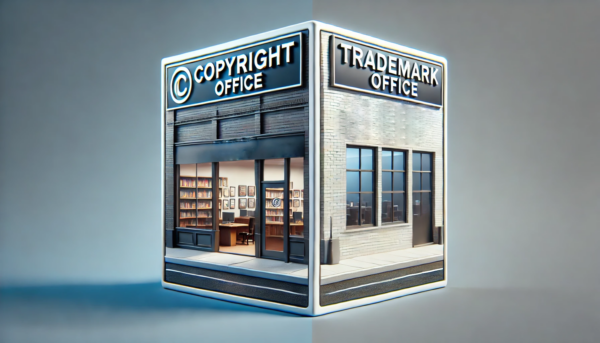Imagine a world where Harry Potter wasn’t trademarked. You’d be wading through shelves of knock-offs like Harry Pottery and the Sorcerer’s Mug, or worse, Larry Potter and the Magical Urn. It sounds funny, but for authors, not protecting your book title can turn into a real-life headache. Your book title is part of your creative work, and without proper legal protection, someone else could swoop in and use it – or something confusingly similar – for their own project.
In this article, we’ll walk you through the process of how to trademark a book title, so your work remains yours. Whether you’ve written a single book or an entire series, understanding the basics of trademarking will help you safeguard your literary brand and ensure that no one rides your coattails to success. Let’s get started on securing your title and protecting your creative vision!
What is Trademark Law and How Does It Apply to Book Titles?
Trademark law, simply put, is the legal framework that helps protect brands, names, logos, and slogans from being used by others in a way that could cause confusion among consumers. It’s what prevents a company from slapping their own name on a product identical to yours and stealing your thunder. When it comes to books and creative works, however, trademarking a title isn’t as straightforward as trademarking a logo or product name.
Your Publishing Journey Awaits – Start NowThe reason? Trademark law typically doesn’t allow single book or series titles to be trademarked. A singular book title is seen as more descriptive than brand-defining. Think of it this way: while it would be hard to trademark a single book title like A Tale of Two Cities, a series title like Chicken Soup for the Soul is much easier to protect because it represents a continuing body of work—making it a “source identifier” in the eyes of the law.
Here’s where things get tricky (and a little humorous): if you don’t trademark your series title, you could end up competing with a confusingly similar name, like Chicken Stew for the Heart. Imagine readers scratching their heads in the bookstore, wondering which comfort food-inspired collection to pick! That’s why trademark protection matters, especially for book series.
Trademarking your book title is about safeguarding your literary brand and ensuring that no one else can capitalize on your hard work.
Trademarking Individual Book Titles
While it’s generally not possible to trademark individual book titles as standalone works, there are some notable exceptions. Trademark law typically requires that a mark be used to identify the source of goods or services, and a single book title doesn’t usually meet this requirement. Think of it like this: a single book title is seen more as a descriptor of that one work rather than a brand identifier.
However, if a book title is used as a brand identifier for a series of books, it can indeed be trademarked. For example, the title Harry Potter isn’t just a single book; it’s a brand that represents an entire series of magical adventures. This makes it eligible for trademark protection because it serves as a “source identifier” for a collection of works.
So, while you might not be able to trademark a one-off title like The Great Adventure, if you’re planning a series under a unified title, you’re in a much stronger position to secure trademark protection.
Requirements for Trademark Registration
To register a trademark for your book title, you’ll need to meet several key requirements. First and foremost, your book title must be unique and not already in use by another party. This means conducting a thorough search to ensure your title stands out in the literary landscape.
Next, you must have a bona fide intention to use the mark in commerce. This isn’t just about having a great title; it’s about actively using it in the marketplace. You’ll also need to file a trademark application with the United States Patent and Trademark Office (USPTO). This application should include a specimen of the mark as it’s used in commerce—think of it as a snapshot of your title in action, whether on a book cover or promotional material.
Finally, you’ll need to provide a detailed description of the goods or services associated with your mark. This helps the USPTO understand exactly how your title is being used and ensures it’s categorized correctly.
Do You Really Need a Trademark Attorney?
You might be wondering if you really need a trademark attorney to help you trademark your book title. While it’s possible to navigate the application process on your own, a trademark attorney can be a valuable ally, especially when things get complicated. They’re experts in trademark law and can help you avoid costly mistakes, like missing key deadlines or choosing a name that could lead to legal conflicts.
If your situation is straightforward, you might not need one. But if there’s any potential conflict with existing trademarks, or if you’re trademarking a series title and want to ensure maximum protection, having an attorney can be a game-changer. They can conduct a thorough search to identify any issues before you file, saving you time and headaches down the road.
Your Publishing Journey Awaits – Start NowMany trademark attorneys offer a free strategy call, so you can get expert advice before deciding whether you need full legal support. It’s a good way to understand your options and see if hiring trademark counsel is right for your project. After all, protecting your book title is an investment in your creative work!
Trademark Class for Books
When filing a trademark application for your book title, you’ll need to specify the class in which your mark is used. The USPTO categorizes all products and services into 45 separate classes, and books fall into International Classes 9 and 16.
Class 9 includes books, e-books, and other written works in digital formats. So, if your book is available as an e-book or audiobook, this is the class you’ll be dealing with. On the other hand, Class 16 covers printed matter, such as physical books, magazines, and newspapers.
When you file your trademark application, make sure to specify the correct class to ensure your title is protected in the right category. This step is crucial for securing comprehensive trademark protection for your literary work.
Trademarking a Book Title: The Application Process
Ready to trademark your book title? Let’s break down the steps, so you know exactly what to expect when navigating the whole trademark registration and application process.
Accurately completing trademark applications is crucial to avoid denial, especially when filing with the U.S. Patent and Trademark Office.
1. Conduct a Thorough Trademark Search
Before you submit your application, it’s crucial to perform a thorough trademark search using the USPTO’s TESS database. This helps you find out if your title (or something confusingly similar) is already trademarked. It’s like searching for your dream home—make sure no one else has already claimed it before you move in!
2. Submit the Trademark Application
Once you’re confident that your title is unique, you can file your trademark application with the U.S. Patent and Trademark Office (USPTO). You’ll need to provide details about your book title, its intended use, and pay a filing fee. The process is fairly straightforward, but double-check everything—you don’t want to miss a step!
3. The Examining Attorney Steps In
After you submit your application, an examining attorney at the USPTO will review it. Their job is to ensure there are no legal conflicts with existing trademarks. If they find issues, they’ll issue an “Office Action,” asking you to respond or fix the problem. No need to panic—this is all part of the process.
4. Publication in the Official Gazette
If your application passes the examining attorney’s review, it will be published in the Official Gazette—which sounds fancy, but is really just a public listing of pending trademarks. During the 30-day opposition period, others can challenge your trademark if they believe it infringes on their rights. Think of it as a “speak now or forever hold your peace” moment.
5. The Filing Date and Your Rights
The filing date of your application is crucial. Once filed, you gain priority over anyone who tries to claim a similar title after that date. It’s like reserving your spot in line, ensuring you’re first in line for trademark protection.
Trademarking a book title takes time, but it’s worth the effort to secure your creative work and protect your rights!
Benefits of Trademarking a Book Title
Trademarking your book title can offer a host of benefits that go beyond just legal protection. First, it helps prevent others from using your title in a way that could cause confusion among readers. Imagine the frustration of seeing a similar title on a different book, leading your audience to mistake it for your work.
Second, trademarking your title establishes it as a brand identifier, increasing its value and recognition. Think of iconic titles like The Hunger Games or Game of Thrones—these aren’t just book titles; they’re powerful brands.
Third, having a registered trademark provides a solid basis for legal action against infringers. If someone tries to ride on the coattails of your success with a confusingly similar title, you’ll have the legal backing to protect your work.
Your Publishing Journey Awaits – Start NowFinally, trademarking helps prevent others from using a similar title in a way that could dilute the distinctiveness of your original title. Your book deserves to stand out, and trademark protection ensures it does.
Potential Conflicts: What If Someone Else Has the Same or Similar Name?
So, what happens if your book title bumps into an existing trademark? If your title is too similar to one that’s already registered, you may run into issues with what trademark law calls “consumer confusion.” This means that if someone sees your book, they might think it’s associated with an already established brand or series, which can lead to legal trouble.
Federal trademark registration can protect a book series title by providing legal rights, including the ability to take legal action against infringement, which strengthens the overall protection of a creative work.
In trademark law, “confusingly similar” refers to titles that are close enough in name, theme, or genre that they could easily be mistaken for each other. For example, imagine two authors both releasing titles about magical adventures: Wizards in Wonderland and Warlocks in Wonderland. They sound close enough that readers might get confused—especially if both books are in the same fantasy genre.
If a potential conflict between trademark registrations arises, don’t panic. You have options! First, you could consider tweaking your title to avoid confusion. Or, if you believe your title has strong artistic relevance or is sufficiently distinct, you might want to work with a trademark attorney to prove it’s not infringing on the other trademark. If all else fails, proving that your title has a clear and unique identity may help you navigate the conflict and still protect your creative work.
Taking steps to address potential conflicts early can save you trouble—and keep your book title uniquely yours.
Common Mistakes to Avoid
When it comes to trademarking your book title, there are several common mistakes you’ll want to steer clear of. First, always conduct a thorough search of existing trademarks to ensure your title isn’t already in use. Overlooking this step can lead to costly legal conflicts down the road.
Second, remember that your title must be used in commerce. Simply having a great title isn’t enough; it needs to be actively used in the marketplace to qualify for trademark protection.
Third, make sure your trademark application is complete and accurate. This includes providing a specimen of the mark and a detailed description of the goods or services it’s associated with. Incomplete applications can lead to delays or even rejections.
Finally, respond promptly to any office actions or communications from the USPTO. Ignoring these can jeopardize your application and delay the protection of your title. By avoiding these common pitfalls, you’ll be well on your way to securing your book title and protecting your creative work.
Trademarking a Series Title vs. a Stand-Alone Book
When it comes to trademarking, there’s a big difference between protecting a series title and a stand-alone book title. A single book title is often seen as descriptive, which makes it harder to trademark. But when you’re dealing with a series title, it’s a whole different story—literally! A book series title acts as a “source identifier,” meaning it points to a continuing collection of works by the same author or publisher. This gives you far more protection under trademark law.
Think of it like this: trademarking a single book title is like building a moat around one castle. It’s helpful, but not nearly as strong as trademarking a series, which is like fortifying an entire kingdom with walls, towers, and guards. Your series title becomes a brand in itself, making it easier to defend against copycats.
So, if you’re planning on releasing a series of books, trademarking the title gives you more security and helps establish your literary empire!
Protecting Your Creative Work Is Worth It
Trademarking your book title is an important investment in protecting your creative work. By taking this step, you’re safeguarding your title and ensuring that no one else can claim it or create something confusingly similar. The peace of mind that comes with legal protection and trademark rights is invaluable, especially when it comes to building your brand as an author.
So, don’t leave your book title vulnerable—take action and secure it. After all, you’d hate to see your beloved title turned into a knock-off version out in the wild. Your masterpiece deserves to stand out, not share the spotlight with an unoriginal imitation!
Feeling overwhelmed with the trademarking process as well as all of the publishing details? Let Spines take some of that off your plate! While you advocate for and trademark your creative work, we can help edit, proofread, design, and publish your work with the click of a button! Check us out today!








